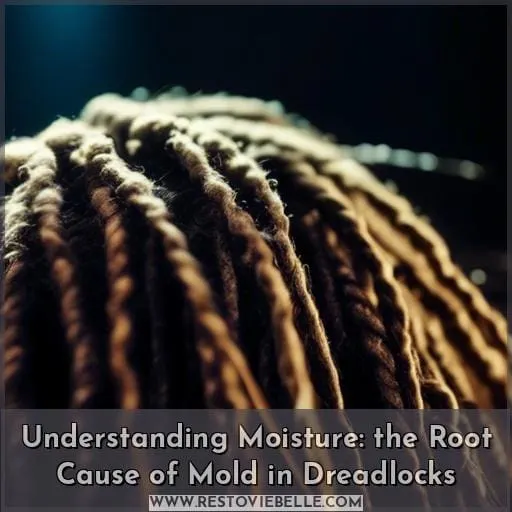This site is supported by our readers. We may earn a commission, at no cost to you, if you purchase through links.
 Discovering mold in your dreadlocks can be unsettling, but it’s a challenge you can tackle with the right knowledge.
Discovering mold in your dreadlocks can be unsettling, but it’s a challenge you can tackle with the right knowledge.
Moisture is the main culprit behind mold growth, often leading to an unpleasant musty odor. If you’re noticing a persistent smell, especially when your dreads are wet, it’s time to take action.
This guide will walk you through the signs of mold in dreads, how to prevent it, and effective treatments to restore the health and freshness of your locks.
Let’s dive into maintaining your dreadlocks mold-free, ensuring they remain as vibrant and healthy as the day you started them.
Table Of Contents
- Key Takeaways
- Understanding Moisture: the Root Cause of Mold in Dreadlocks
- Identifying Mold in Dreadlocks: the Telltale Signs
- Preventing Mold in Dreadlocks: Effective Strategies
- Treating Mold in Dreadlocks: Remedies and Solutions
- Maintaining Healthy Dreadlocks: Long-term Care and Considerations
- Frequently Asked Questions (FAQs)
- Can mold in dreadlocks cause health issues beyond the scalp, such as respiratory problems or allergic reactions?
- How does the climate or living environment (e.g., humid vs. dry areas) affect the likelihood of developing mold in dreadlocks?
- Are there specific hair types or textures more prone to developing mold in dreadlocks, and if so, why?
- Can the use of certain hair products or treatments (outside of those mentioned for prevention and treatment) exacerbate the risk of mold growth in dreadlocks?
- How does the length and thickness of dreadlocks impact the drying process and the potential for mold development?
- Conclusion
Key Takeaways
- Moisture is the primary cause of mold growth in dreadlocks, and ensuring they are thoroughly dried after washing is crucial for prevention.
- Signs of mold in dreadlocks include a persistent musty odor, unusual discoloration or spots, and changes in texture such as brittleness.
- Preventative measures include using residue-free shampoos, avoiding moisture-retaining products like wax, and incorporating natural antifungals like tea tree oil.
- Treatment options for mold in dreadlocks include apple cider vinegar rinses, cautious use of baking soda, and lemon juice to help reduce discoloration and treat mold.
Understanding Moisture: the Root Cause of Mold in Dreadlocks
Understanding the role of moisture in the health of your dreadlocks is crucial.
Moisture, when not managed properly, can become the root cause of mold growth within the dense structure of dreadlocks. This is because the trapped moisture creates an ideal environment for mold to thrive, especially when combined with poor hygiene practices and inadequate drying techniques.
To maintain the health of your dreadlocks, it’s essential to incorporate effective moisture management strategies into your hair care routine. This includes adopting styling techniques that allow your locks to dry thoroughly, especially after washing or exposure to wet conditions.
Environmental factors, such as humidity, can also contribute to moisture buildup, so it’s important to adjust your hair care practices accordingly.
By understanding the significance of moisture management and implementing proper hygiene practices, you can prevent mold growth and maintain healthy, vibrant dreadlocks.
Identifying Mold in Dreadlocks: the Telltale Signs
Having explored the crucial role moisture plays in the development of mold within dreadlocks, it’s essential to recognize the signs that indicate its presence. Mold in dreadlocks isn’t just a cosmetic issue; it’s a health concern that requires your attention.
Odor Detection: The most unmistakable sign is a persistent, musty smell reminiscent of a wet dog or a mildewed towel. This scent is particularly noticeable when your dreadlocks are damp and may diminish once they dry, but don’t be fooled—the problem still lurks within.
Visual Clues: While a change in color or texture might suggest residue buildup, mold appearance is distinct. Look for any unusual discoloration or spots within the dreadlocks. If you spot any signs of blue-green or black hues, it’s time to consider mold treatment.
Physical Changes: If your dreadlocks feel unusually brittle, dry, or fragile, it could be a sign of mold damage. Mold can compromise the integrity of your hair, leading to breakage and weakness.
To maintain the health and beauty of your dreadlocks, it’s crucial to adopt a mold management strategy that includes regular moisture balance, avoidance of heavy products, and thorough drying after washing.
By staying vigilant and proactive, you can prevent the onset of mold and keep your dreadlocks in pristine condition.
Preventing Mold in Dreadlocks: Effective Strategies
After identifying the signs of mold in your dreadlocks, it’s crucial to focus on prevention.
- Ensure Proper Drying: Always dry your dreadlocks thoroughly after washing. Use a towel to gently squeeze out excess water, then air dry or use a hairdryer on a low setting. Remember, dampness is the enemy, so take the time to dry each loc completely.
- Choose the Right Products: Opt for dreadlock-friendly shampoos that don’t leave residue and avoid moisture-retaining products like wax. Instead, consider using tea tree oil, which has natural antifungal properties and can help keep your scalp and locs healthy.
- Regular Maintenance: Removing loose hair by retwisting or using a crochet hook can prevent it from trapping moisture and contributing to mold growth. Regular maintenance keeps your dreadlocks neat and less prone to mold.
By incorporating these strategies into your routine, you’ll not only prevent mold but also maintain the health and beauty of your dreadlocks. Remember, prevention is always better than cure, so be proactive in caring for your locs.
Treating Mold in Dreadlocks: Remedies and Solutions
After diligently working on preventing mold in your dreadlocks, discovering mold can be disheartening. However, don’t lose hope. There are effective remedies and solutions to treat mold and restore the health of your dreadlocks.
Start with an apple cider vinegar (ACV) rinse. ACV’s acetic acid acts as a powerful antimicrobial, killing bacteria and fungus, thus addressing the root cause of mold. Combine it with baking soda for a deep cleanse that removes buildup, leaving your scalp fresh and your dreadlocks lighter.
However, be cautious with baking soda; its alkaline nature can be harsh, so limit its use to avoid damaging your hair.
Tea tree oil is another potent ally. Its antifungal, antiviral, and antibacterial properties make it an excellent choice for eliminating mold and preventing future occurrences. You can add a few drops to your shampoo or mix it with a carrier oil and apply it directly to your scalp.
Hydrogen peroxide offers a more aggressive approach for stubborn mold. It’s effective on solid surfaces but use it with caution on hair to avoid unwanted bleaching. Spray a 3-percent solution onto the affected area, let it sit, then rinse thoroughly.
Lastly, lemon juice, with its natural acidity, can help in treating mold. Its lightening properties might also reduce the visibility of any mold-related discoloration.
Maintaining Healthy Dreadlocks: Long-term Care and Considerations
To maintain healthy dreadlocks and prevent issues like mold, it’s crucial to strike the right moisture balance.
Using lightweight, moisturizing products will help keep your dreads healthy without weighing them down. Remember, thorough drying is essential to prevent moisture from becoming trapped inside your locs, which can lead to mold growth.
By adhering to these guidelines, you’ll keep your dreadlocks looking and feeling great.
Regular Moisture Balance
To maintain a balanced scalp and prevent mold in your dreadlocks, it’s crucial to manage moisture retention.
Aim for optimal hydration without overdoing it, as excess moisture can lead to mildew. Use drying techniques that ensure your locks are thoroughly dry, especially before bedtime.
Humidity regulation is also key; in damp climates, be extra vigilant with drying. Remember, a healthy dreadlock routine includes keeping the scalp and hair at the right moisture level for resilience and strength.
Avoid Heavy Products
Maintaining the right moisture balance in your dreadlocks is crucial. However, it’s equally important to be mindful of the products you use. Heavy products, especially those laden with unnatural oils and ingredients, can lead to product buildup, excessive greasiness, and negatively impact your scalp health.
These products can clog your hair’s pores, reducing its natural porosity and ability to absorb moisture effectively.
Instead, opt for lightweight, natural oils that nourish without weighing down your locks. Ingredients like coconut, jojoba, and tea tree oils are excellent choices as they support scalp health and ensure your dreadlocks remain healthy and vibrant.
Thorough Drying Required
After avoiding heavy products, it’s crucial to ensure your dreadlocks are thoroughly dried to prevent mold.
- Squeeze Out Water: Start by gently squeezing water from your locks, moving from roots to tips.
- Towel Drying: Wrap a microfiber towel around your locks, pressing gently to absorb moisture without twisting.
- Air or Blow Drying: Let them air dry if the weather permits. Otherwise, use a blow dryer on a low heat setting to avoid damage.
- Sun Drying: If possible, sun drying can be an effective method, but ensure your locks aren’t left damp inside.
Frequently Asked Questions (FAQs)
Can mold in dreadlocks cause health issues beyond the scalp, such as respiratory problems or allergic reactions?
Yes, mold in dreadlocks can lead to respiratory problems or allergic reactions.
Especially in those with respiratory diseases or compromised immune systems.
How does the climate or living environment (e.g., humid vs. dry areas) affect the likelihood of developing mold in dreadlocks?
Living in humid areas increases your risk of mold in dreadlocks due to persistent moisture. Mold spores thrive on this environment. Dry climates are less conducive to mold growth.
Are there specific hair types or textures more prone to developing mold in dreadlocks, and if so, why?
No specific hair types or textures are inherently more prone to developing mold in dreadlocks. Mold growth in dreads, often referred to as dread rot, is primarily caused by not allowing the dreads to dry properly after washing.
The compact nature of dreadlocks can trap moisture, creating an environment conducive to mold growth, regardless of hair type. Proper drying and maintenance are key to preventing mold, emphasizing the importance of thorough drying and avoiding practices that retain moisture, such as using waxes.
Can the use of certain hair products or treatments (outside of those mentioned for prevention and treatment) exacerbate the risk of mold growth in dreadlocks?
Certain hair products, especially those containing wax, can trap moisture and debris, creating a breeding ground for mold in your dreadlocks.
How does the length and thickness of dreadlocks impact the drying process and the potential for mold development?
Longer, thicker dreadlocks take more time to dry, increasing the risk of mold since moisture gets trapped inside.
It’s crucial to thoroughly dry your dreads to prevent this.
Shorter, thinner dreads dry faster, reducing mold risk.
Conclusion
Imagine loving your dreadlocks for their unique journey, much like the Reddit user who cherished the natural evolution of their locks but faced the harsh reality of mold in dreads.
Don’t let mold take away from the beauty and individuality of your dreads. By understanding moisture’s role, recognizing the signs, and employing prevention strategies, you can tackle this issue head-on.
If you’re already facing dread-rot, remember that treatment is possible with patience and the right approach. Keep your dreadlocks healthy and vibrant by balancing moisture, avoiding heavy products, and ensuring thorough drying.
Your dreads are a part of you—treat them with the care they deserve.











